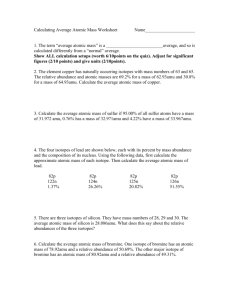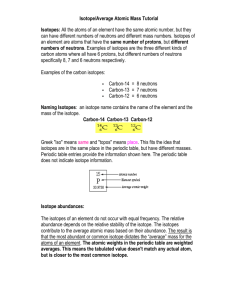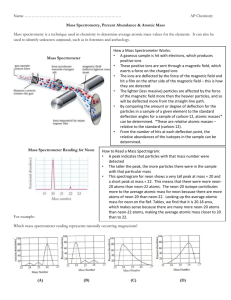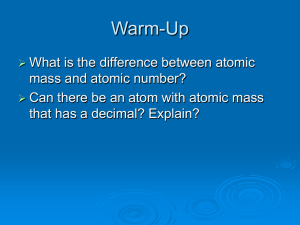2.03 Guided Notes
advertisement
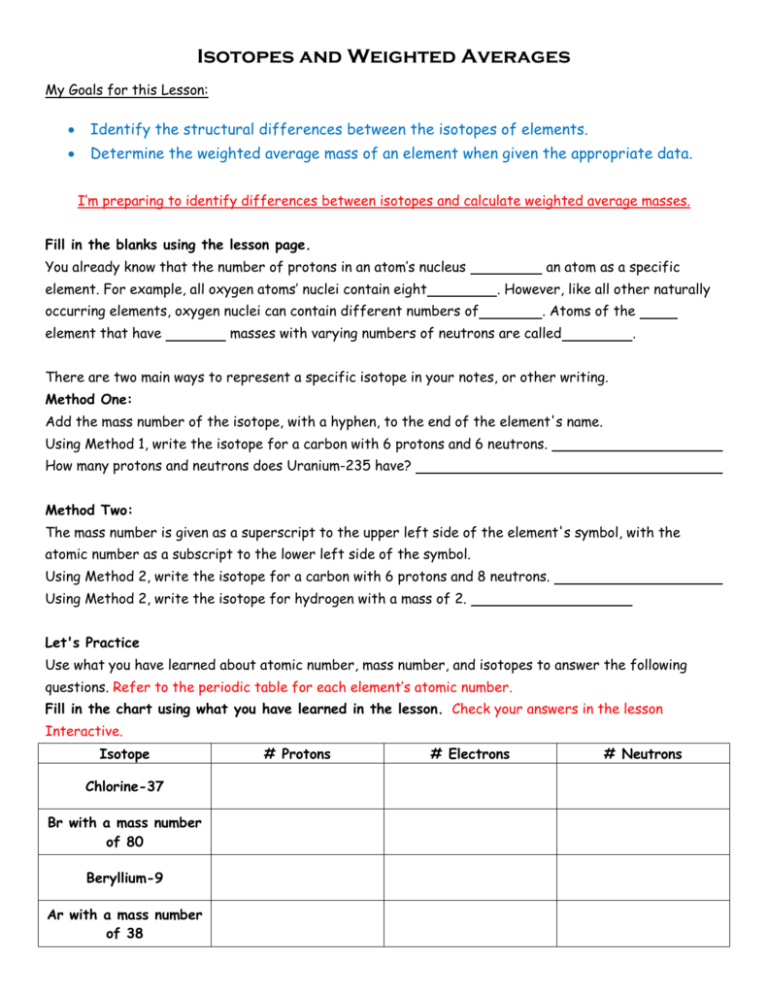
Isotopes and Weighted Averages My Goals for this Lesson: Identify the structural differences between the isotopes of elements. Determine the weighted average mass of an element when given the appropriate data. I’m preparing to identify differences between isotopes and calculate weighted average masses. Fill in the blanks using the lesson page. You already know that the number of protons in an atom’s nucleus element. For example, all oxygen atoms’ nuclei contain eight an atom as a specific . However, like all other naturally occurring elements, oxygen nuclei can contain different numbers of element that have . Atoms of the masses with varying numbers of neutrons are called . There are two main ways to represent a specific isotope in your notes, or other writing. Method One: Add the mass number of the isotope, with a hyphen, to the end of the element's name. Using Method 1, write the isotope for a carbon with 6 protons and 6 neutrons. How many protons and neutrons does Uranium-235 have? Method Two: The mass number is given as a superscript to the upper left side of the element's symbol, with the atomic number as a subscript to the lower left side of the symbol. Using Method 2, write the isotope for a carbon with 6 protons and 8 neutrons. Using Method 2, write the isotope for hydrogen with a mass of 2. Let's Practice Use what you have learned about atomic number, mass number, and isotopes to answer the following questions. Refer to the periodic table for each element’s atomic number. Fill in the chart using what you have learned in the lesson. Check your answers in the lesson Interactive. Isotope Chlorine-37 Br with a mass number of 80 Beryllium-9 Ar with a mass number of 38 # Protons # Electrons # Neutrons Average Atomic Mass Fill in the blanks using the lesson page. You may have noticed that the atomic mass values given on the periodic table have values even though the mass numbers for individual atoms are numbers. This is a result of averaging the mass values for all the element’s Most elements found in nature occur as a mixture of two or more . . The percentages of each isotope in the mixture are the same in every sample of a given element, no matter where on Earth the samples are collected. Because pure elements are made up of mixtures of , it is important to take into account the percentage and mass of each , especially when some make up a greater percentage of the mixture than other . To do this, the average atomic mass of each element is calculated using a weighted average. What is a weighted average? A weighted average accounts for the percent abundance and mass of each isotope in an element. Imagine that a class of 100 students took a test worth 100 points. If all of the students scored 80 out of 100 on the test, the average score for the class would be 80. If just one of the students scored 90 out of 100 on the test, what would happen to the class average? The class average would be slightly higher than 80 because of that one higher score. Similarly, most carbon atoms are the carbon-12 isotope. One out of every 100 carbon atoms is the slightly heavier carbon-13 isotope. This small amount of carbon-13 raises the average mass of carbon from exactly 12.000 u to the slightly higher mass of 12.010 u. This is the mass that you see on the periodic table. The average atomic mass of an element can be calculated by multiplying the mass of each isotope by its relative abundance (the percentage represented in decimal form) and adding the results. Isotope A [percent abundance × mass] + Isotope B [percent abundance × mass] + continue for each isotope = average atomic mass Example Isotope Mass Percent Abundance Oxygen-16 16.0 u 99.762% Oxygen-17 17.0 u 0.038% Oxygen-18 18.0 u 0.200% This information will be given to you in the problem. Percent Value changed to decimal. 0.99762 0.00038 0.00200 [0.99762 × 16.0 u] + [0.00038 × 17.0 u] + [0.00200 × 18.0 u] = 16.0 u This is the work you will need to show for credit on these types of problems. (Note that the percentages do not count toward significant figures because they are counted, not measured.) Let's Practice Question One: Copper has two naturally occurring isotopes. Copper-63, with an atomic mass of 62.94 u, makes up 69.17 percent of the sample, and Copper-65, with an atomic mass of 64.93 u, makes up the other 30.83 percent. Calculate the weighted average atomic mass of copper based on the given information. Please give your answer in a total of four significant figures. Isotope Mass Percent Abundance Copper-63 Copper-65 This information is given to you in the problem. Percent Value changed to decimal. [Abundance (decimal form) × atomic mass (u)] + [Abundance (decimal form) × atomic mass (u)] = weighted average atomic mass (u) [ x u] + [ x u] = u Question Two: Three isotopes of argon (Ar) occur in nature. Argon-36 (35.968 u) makes up 0.337 percent of the sample, Argon-38 (37.963 u) makes up 0.063 percent of the sample, and Argon-40 (39.962 u) makes up the other 99.6 percent of the sample. Calculate the weighted average atomic mass of argon, giving your answer in a total of five significant figures. Isotope Mass Percent Abundance Percent Value changed to decimal. This information is given to you in the problem. [Abundance (decimal form) × atomic mass (u)] + [Abundance (decimal form) × atomic mass (u)] + [Abundance (decimal form) × atomic mass (u)] = weighted average atomic mass (u) [ x u] + [ x u] + [ x u] = u Question Three: Imagine that scientists discovered a new element, given the symbol X. If 93.7 percent of the sample is an isotope with a mass of 272.98 u and the rest of the sample is an isotope with a mass of 275.96 u, what is the average atomic mass of the sample? Please give your answer in a total of five significant figures. Isotope Mass Percent Abundance Percent Value changed to decimal. 100 – 93.7 = _______ This information is given to you in the problem. [Abundance (decimal form) × atomic mass (u)] + [Abundance (decimal form) × atomic mass (u)] = weighted average atomic mass (u) [ x u] + [ x u] = u The average atomic masses that are given on the periodic table are important to chemists because they represent the masses of the naturally occurring mixture of isotopes for each element. This means that when we use the average atomic mass from the periodic table in a calculation, we are taking into account that a sample of a given element is made up of a specific mixture of its isotopes. Because these mixtures of isotopes occur naturally, we will use the average atomic mass values from the periodic table in most of the calculations in this course.




